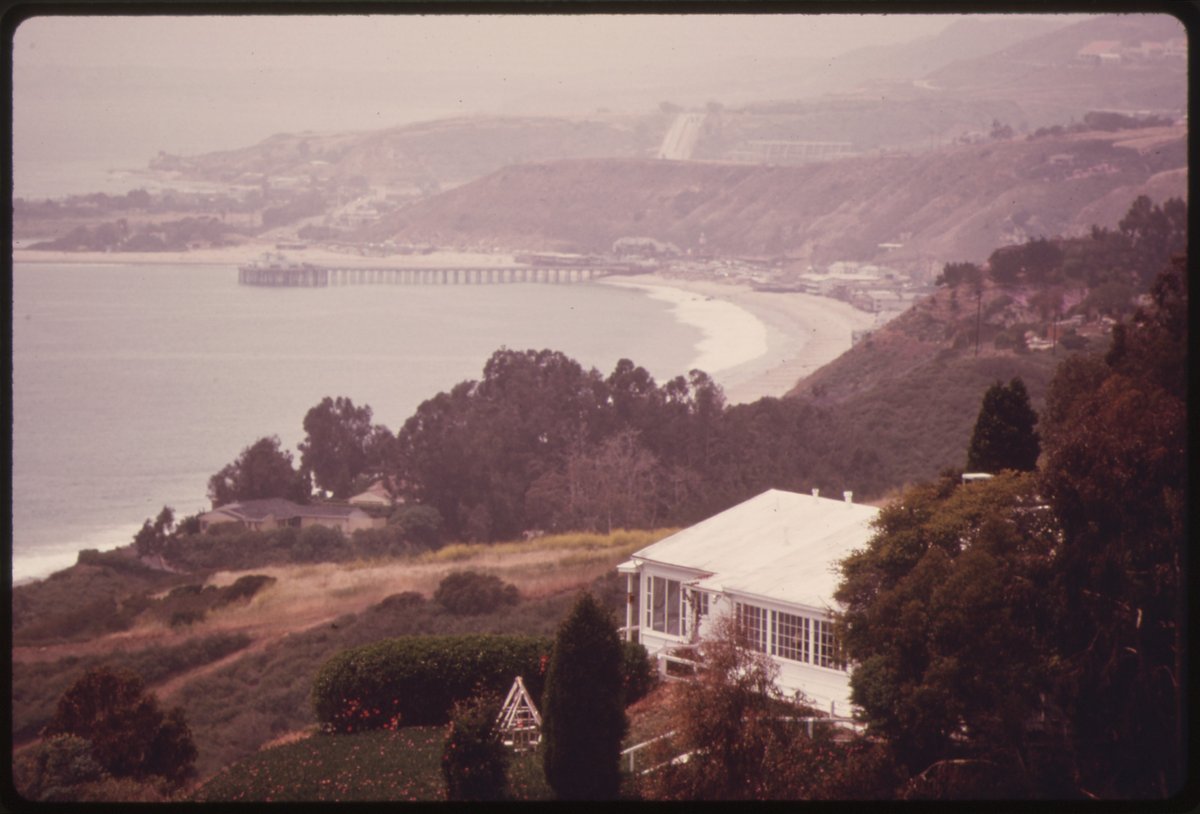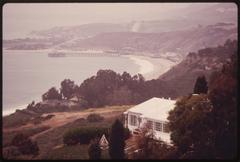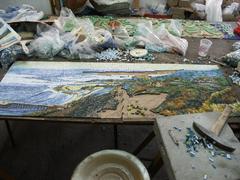
Malibu Pier Visiting Hours, Tickets, and Travel Guide
Date: 14/06/2025
Introduction: Discover Malibu Pier
Malibu Pier is a treasured icon of Southern California’s coastline, seamlessly blending a rich historical legacy with vibrant contemporary appeal. Established in 1905 by Frederick Hastings Rindge, the pier was originally built to serve as a shipping dock for the sprawling Rancho Malibu estate. Over the decades, it has evolved into a beloved public landmark, offering sweeping views of the Pacific Ocean, abundant fishing opportunities, and a direct connection to Malibu’s unique coastal heritage.
The area’s legacy is deeply rooted in the Chumash people, Malibu’s first inhabitants, whose presence and influence are still felt. Today, visitors to Malibu Pier can expect a welcoming atmosphere, easy access, and a range of experiences—from fishing and wildlife watching to dining, shopping, and exploring nearby historical sites. This comprehensive guide covers everything you need to plan your visit, including Malibu Pier visiting hours, ticket policies, travel tips, and attractions.
For up-to-date information, consult the official Malibu Pier website and other trusted travel resources (brianmerrick.com; malibupier.com; timeout.com).
Table of Contents
- Indigenous Roots and Early Settlement
- The Construction and Early Purpose of Malibu Pier
- Evolution into a Recreational Landmark
- Wartime and Postwar Significance
- Preservation, Restoration, and Modern Era
- Visitor Information
- Attractions and Activities
- Practical Tips for Visitors
- Frequently Asked Questions (FAQ)
- Conclusion and Visitor Recommendations
- Sources and Further Reading
Indigenous Roots and Early Settlement
The land surrounding Malibu Pier has a history dating back thousands of years to the Chumash people, who named the area “Humaliwo,” meaning “the surf sounds loudly.” The Chumash established villages near Malibu Lagoon, relying on the abundant resources of the coast for sustenance and trade. Spanish colonization in the 18th century transformed the region, and by the 19th century, the land became part of Rancho Topanga Malibu Sequit. In the late 1800s, Frederick Hastings Rindge and his wife, Rhoda May Knight Rindge, acquired the land, fiercely protecting it and laying the foundation for modern Malibu.
The Construction and Early Purpose of Malibu Pier
Built in 1905 by Frederick Hastings Rindge, Malibu Pier was initially designed as a practical shipping dock for transporting agricultural products and building materials from the isolated Rancho Malibu. The original wooden structure overcame challenging Pacific conditions, providing a crucial link between Malibu and the markets of Los Angeles. Its iconic design, including red-roofed buildings and a simple boardwalk, quickly became a defining feature of the coastline.
Evolution into a Recreational Landmark
By the 1930s, Malibu Pier shifted from commercial use to a public recreational facility. Officially opened to the public in 1934 and extended to 780 feet in 1938, the pier soon attracted anglers, sightseers, and vacationers. Storm damage in 1929 led to a concrete reconstruction, ensuring its durability. The opening of bait shops, restaurants, and other businesses cemented Malibu Pier’s reputation as a vibrant community hub and a gateway to the Pacific.
Wartime and Postwar Significance
During World War II, Malibu Pier served as a U.S. Coast Guard lookout, reflecting its strategic importance. After the war, Malibu’s popularity soared, with the pier becoming a magnet for surfers, fishermen, and Hollywood celebrities. The adjacent Surfrider Beach gained fame as the world’s first surfing reserve and a symbol of California surf culture.
Preservation, Restoration, and Modern Era
The State of California acquired Malibu Pier in the 1980s, ensuring its preservation as a public resource. Severe storms in the 1990s caused major damage, leading to a full closure from 1997 to 2008. Restoration efforts faithfully preserved the pier’s historic charm while upgrading its facilities. The 2008 reopening marked a new era, with the pier now managed by California State Parks and remaining a beloved destination for visitors and locals alike (parks.ca.gov).
Visitor Information
Visiting Hours and Tickets
- Hours: Malibu Pier is open daily from 6:00 AM to 10:00 PM for public access (malibupier.com).
- Admission: There is no general admission fee to stroll the pier. Some events, restaurants, or guided tours may require reservations or tickets.
Accessibility
- Wheelchair Accessibility: The pier is fully accessible, with ramps and flat surfaces.
- Restrooms: Accessible restrooms are available on-site.
- Strollers: Smooth surfaces make it easy for families with strollers.
Directions and Parking
- Address: 23000 Pacific Coast Highway, Malibu, CA 90265 (malibupier.com).
- Parking: Paid parking is available in lots near the pier (typically around $8 per vehicle). Arrive early, especially on weekends, as spots fill quickly (misstourist.com).
- Public Transit: The 534 MTA bus from Los Angeles and Santa Monica stops directly at the pier.
Amenities and Facilities
- Dining: Malibu Farm Restaurant and Café offer fresh, organic, California-inspired menus with ocean views.
- Shopping: Boutiques provide beachwear, gifts, and artisan goods.
- Fishing Rentals: Rods, tackle, and bait are available for rent at Ranch at the Pier.
- Seating: Benches and shaded areas for relaxation.
Attractions and Activities
Fishing and Wildlife Watching
Fishing from Malibu Pier has been a beloved pastime since 1938. No fishing license is required when angling from the pier. Expect to catch halibut, mackerel, and more. Wildlife enthusiasts can spot pelicans, dolphins, sea lions, and even migrating whales during certain seasons.
Surfing and Water Sports
Adjacent Surfrider Beach is a world-renowned surf spot, welcoming surfers from around the globe. Paddleboard and kayak rentals are available nearby, with lessons and tours offered by local outfitters.
Dining and Shopping
Malibu Farm Restaurant and Café serve farm-to-table cuisine with panoramic views. The Ranch at the Pier offers quick bites and fishing supplies. Boutiques on the pier and at Malibu Country Mart feature sustainable and local products.
Events, Guided Tours, and Community Activities
Malibu Pier hosts art festivals, live music, yoga sessions, and fishing tournaments throughout the year. Guided walking and fishing tours are available, providing insights into the pier’s history and marine ecology. For current events, consult the official events calendar.
Nearby Attractions
- Malibu Lagoon State Beach: Ideal for birdwatching and exploring natural wetlands.
- Adamson House and Malibu Lagoon Museum: Explore Malibu’s architectural and indigenous history.
- Malibu Country Mart: Upscale shopping and dining in an open-air setting.
- Getty Villa: A short drive away, featuring ancient art and gardens.
Practical Tips for Visitors
- Best Times: Early mornings and late afternoons offer ideal lighting and fewer crowds.
- Weather: Coastal weather changes quickly—dress in layers and bring sun protection.
- Parking: Arrive early, especially during weekends and holidays.
- Reservations: Recommended for Malibu Farm Restaurant during peak hours.
- Wildlife Watching: Bring binoculars for the best views.
- Accessibility: The pier is wheelchair and stroller friendly.
- Combine Activities: Pair your visit with Surfrider Beach, Malibu Lagoon, or Adamson House for a full day out.
Frequently Asked Questions (FAQ)
Q: What are Malibu Pier’s visiting hours?
A: The pier is generally open daily from 6:00 AM to 10:00 PM, but business hours for shops and restaurants may vary.
Q: Is there an admission fee or are tickets required?
A: No, entry to Malibu Pier is free. Some activities, events, or dining may require reservations or tickets.
Q: Is Malibu Pier wheelchair accessible?
A: Yes, with ramps, handrails, and accessible restrooms.
Q: Can I fish from the pier without a license?
A: Yes, no fishing license is required for pier fishing.
Q: Where can I park, and is it free?
A: Paid parking is available near the pier; limited free street parking available but fills quickly.
Q: Are pets allowed?
A: Leashed pets are permitted on the pier; check specific business policies.
Conclusion and Visitor Recommendations
Malibu Pier is more than a scenic landmark—it is a living testament to Malibu’s heritage, surf culture, and community spirit. With its accessible hours, free entry, and diverse amenities, the pier welcomes families, photographers, outdoor enthusiasts, and history buffs alike. Ongoing restoration ensures the pier retains its historic charm while meeting modern standards. For the optimal experience, visit during early mornings or late afternoons, book dining in advance, and explore nearby attractions to get the most from your Malibu adventure.
For real-time updates, travel tips, and exclusive content, download the Audiala app or follow our social media channels. Extend your journey to Malibu’s other historical and natural treasures to fully immerse yourself in the California coastal experience.
Sources and Further Reading
- Malibu Pier Visiting Hours, Tickets, and History: Your Guide to Malibu’s Iconic Landmark, 2025, Brian Merrick (brianmerrick.com)
- Malibu Pier Visiting Hours, Tickets & Historical Significance, 2025, Timeout Los Angeles (timeout.com)
- Malibu Pier Visiting Hours, Tickets, and Top Attractions in Malibu, 2025, Westside Los Angeles Visitor Guide (westsidelosangeles.com)
- Malibu Pier Visiting Hours, Tickets, and Visitor Guide to Malibu Historical Sites, 2025, Miss Tourist (misstourist.com)
- Malibu Pier Official Website, 2025 (malibupier.com)
- All Things Malibu Events Calendar (allthingsmalibu.com)
- A Pier Like No Other: Exploring the Iconic Malibu Pier in California (medium.com)
- Top Activities Malibu 2025 (gotraveldaily.com)
- California State Parks — Malibu Pier (parks.ca.gov)
- Malibu Pier Overview (scripturesavvy.com)

